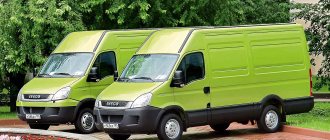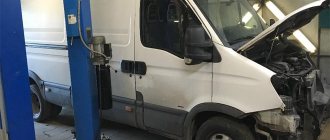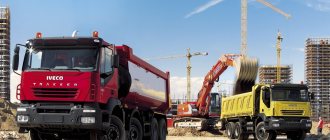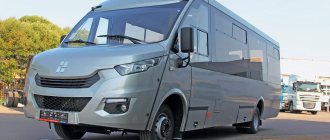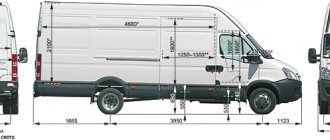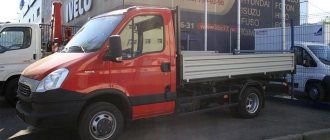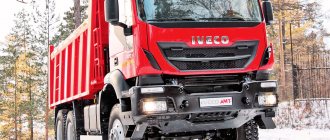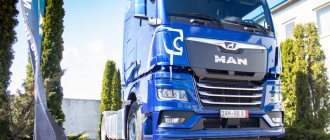The second issue of Autoreview will talk about “alternative” tractors: with electric drives, hybrid... But the most fashionable cargo topic in Europe now is liquefied (namely liquefied, not compressed) and cooled methane. IVECO even stated that the Stralis NP 460, which runs on this fuel, is not inferior to its diesel counterparts! I tested it in the vicinity of Ulm, Germany.
The Ivekovites chose their Magirus plant as the meeting place for the new models. How much has merged in this sound for the Russian heart!
“Near the water, on the descent, there stood a column of yellow German Magirus trucks and honked powerfully, unanimously, at regular intervals... These guys, first-class drivers, by the way, worked only on Magirus, they drove up to six hundred a month, never They didn’t help anyone and didn’t seek help from others, they kept themselves in a contemptuous and proud alienation from their own narrow circle.” This is a quote from Yuri Nagibin’s story “Vasya, Can You Hear It?”, published in 1976.
Then almost ten thousand of these machines came to the Soviet Union for the construction of the BAM - all with air-cooled diesel engines, mostly three-axle dump trucks. Those times are still remembered at the plant: the instructor of one of the vehicles said that when he first started working, he saw trucks from the Soviet order.
The Magirus plant has long specialized in fire fighting equipment
Now the plant, we repeat, belongs to IVECO, and until 2012 Stralis tractors were assembled here. But then Magirus (which has been involved in firefighting since the 19th century) was turned into a center for the construction of fire trucks: everywhere you look - tank trucks, ladders, other “extinguishing apparatus” and preparations for them.
And also military trucks, both sand-colored (it turned out that they were from an order for about 300 copies for Sudan) and NATO ones, dark green.
One was even armored - with flat windshields and bolted hinged panels. Are these cars also assembled here? No, they are just retrofitting them. But I came here for the sake of other IVECOs - civilians!
A million kilometers is not the limit
– We are engaged in transportation; in our fleet there are six Iveco Daily and two Mercedes Atego. My work in this area began in 2014, when the first used Iveco was purchased. Why did you choose this brand? Don't know. She and the GAZelle have one significant advantage - the frame design. The high reliability of the engines played in favor of the choice to some extent. One of my cars, produced in 2011, has over a million miles on it; no one has ever tampered with its engine, and there are no hints of such a need yet.
Another advantage of Iveco is that they can easily withstand overload. Reasonable, of course.
I’ll tell you right away about older specimens. In a 2011 car with a mileage of a million kilometers, the rear axle was rebuilt. Over time, electronic problems arise and different sensors are replaced. Also, due to age, the heater radiators rot, and from time to time you have to rebuild the calipers. Still, with old cars there is less confidence, but with a new one you can safely get in and drive for 5-6 thousand kilometers.
One of my Ivecos has a 2.3 liter engine. It’s hard to say whether it’s worse or better than the three-liter one. It has a timing belt drive, I change the belt once a year. In other cars with three-liter engines, the timing chain is driven by a chain; its lifespan is 240 thousand kilometers, but, as experts say, if it doesn’t rattle, then you shouldn’t touch it. Cars with a mileage of 350-400 thousand still have chains from the factory, and on one with a mileage of a million, the chain was changed at 500 thousand, but it was also in good condition.
The advantage of maintaining a fleet of vehicles from one brand is that it’s easier to find spare parts. I have a small warehouse where I keep “consumables”: filters, oil, pads, discs and wheel bearings.
New cars have minimal problems
The last cars were bought new. Because you simply use them, and after 200 thousand kilometers you don’t have a headache. The terms of the warranty are interesting: in the first year it covers the entire car without any mileage restrictions, in the second it only covers the engine, gearbox and axle, while the mileage is limited to 200 thousand kilometers.
This car is from 2022, its mileage today is about 250 thousand. Under warranty, two ABS sensors, a hydraulic clutch and a wheel bearing were replaced. But the wheel bearing is our fault, we overloaded one side.
But with hydraulic clutch drives it’s not clear. On one car it can easily cost 400 thousand, on another you will have to change it every year. Fortunately, the “pleasure” is not the most expensive - about 200 rubles.
I am satisfied with the warranty service. All problems were resolved without question.
The engine here is three-liter, with a power of 150 horsepower. In another car, an engine of the same volume produces 170 horsepower. There is also a version with two turbines producing 210 horsepower, but it is rare. At a cruising speed of 95 kilometers per hour, fuel consumption is about 14 liters.
The body of the car is Belarusian. The sleeping bag is Czech, but also assembled and installed in Belarus. All this was done upon purchase and was included in the price of the car.
We added some things ourselves: a Webasto with a separate tank, a tool box, a water tank, more serious bump stops, so as not to be afraid to drive up to the ramps. I also installed back the springs from the more heavy-duty version.
The Iveco cabin is comfortable for the driver. Luggage compartment under the seats, niches, table on the back of the passenger seat. Air conditioner. I don’t understand carriers who take “empty” cars and skimp on driver comfort.
Is lighter better?
The Stralis X-Way construction series, the presentation of which took place in Ulm, was probably named in defiance of the Scania XT model, but the competition turned out to be unequal.
After all, the Swedish XT are the latest “builders” of all varieties and types, and the X-Way is a cross between the main-line Stralis and the off-road Trakker model: the result is a vehicle adapted for “European construction”, where there is no serious off-road, and as lightweight as possible (the thickness of the frame side members is only 7 mm, aluminum tanks, etc.). Ivekovites even claim that they are lighter than all competitors: for example, the chassis for an 8x4 concrete mixer weighs less than 8900 kg.
But apparently there are no free cakes! I drove such a loaded 6x2 bunker truck - the steering turned out to be too light, the chassis suffered from strong lateral rocking, and the turbine howled when the robotic gearbox was switched. Moreover, because of the software of the new ZF TraXon box, I almost got into trouble.
I approach a T-junction, stand on the rise, letting cross traffic pass, Drive is on in the box. A window appeared in the traffic - I pressed on the gas, but the Stralis didn’t even move. I, not understanding what’s going on, continue to press the pedal, and the cars are already approaching. And suddenly IVECO starts! And I have nothing to do with it, these are all electronic settings. I can assure you: DAFs equipped with exactly the same “robot” (including the lightweight version of Lightweight, which is mentioned in the same issue) have nothing of the kind.
The impression of this puncture was not erased even by a subsequent trip on an 8x4 dump truck (it behaved better) and an uphill climb on a 4x2 tractor with hydraulic motors in the front wheels. Hydraulics help to drive where rear-wheel drive is powerless, but other manufacturers also have this version, and I talked in detail about the Mercedes Arocs tractor with this system (there it is called HAD).
And in general, many European truck manufacturers have lightweight models - and no one considers them anything special! For us, these “Eurobuilders” with their weakened chassis (let’s call a spade a spade) are generally irrelevant. But another newcomer, the methane Stralis NP 460 - what can it do and how does it behave?
The weak point is the wiring
Iveco has only one drawback - wiring. All wires go corrugated along the frame. Two or three winters - and it rots, the contacts become covered with oxide. Vibrations cause the wires in the corrugation to fray.
Mirrors can also be considered weak points. They become loose over time and are also easy to break.
After two years of use, there is not a hint of rust on the car, except that you can see it on the muffler. True, I processed the frame, but I can say that even on 2014 cars the frames are in excellent condition. Of course, they do not last forever, but it takes a long time for rust to appear.
In fact, the design of modern Iveco Daily has not changed since 2007. The frame, axles, suspension - everything remains the same, only the cabin and cardan have changed. Well, the engines have been modernized to comply with environmental standards from Euro-3 to Euro-5. I have now ordered a new car with an engine that meets Euro 6 requirements - we’ll see.
I can't say whether these cars are cheap or expensive to maintain. For example, good brake pads - 120-130 rubles, brake discs - also 120-130 rubles per one. There is a plus: the wheel bearing is changed separately from the hub. Once a year, you regularly have to replace your windshield under CASCO insurance – production costs. The price of glass is 700 and a penny of dollars.
In Russia there is a wonderful club Iveco Daily. Thanks to him, minor breakdowns can be easily repaired in Moscow; I even changed the clutch in one of my cars there. There were problems with it, and the driver simply stopped by the service center, where they carried out repairs. The cost of parts and labor is the same as here, if not cheaper. And there is no need to transfer spare parts or tow the car to Minsk.
I cannot compare Iveco with any other machines, since I have no experience in operating them. Everyone praises their swamp. Despite the fact that for the price of a Daily you can buy two GAZelles, I am sure that the car is worth the money. In addition, it has good liquidity. In five years it loses less than half its value. And Iveco sells quickly. The all-metal van was taken from me two days after posting the ad, and the refrigerator with 800,000 miles “gone” in three weeks.
Commercial vehicles in the Automotive Business ad database
Methane-powered tractor: a trucker's dream or a headache?
All holders of category “C” rights consider themselves professionals. Those who have been driving trucks for several years are often overconfident. In fact, even experienced drivers often make mistakes and at the same time blame their equipment. This statement is especially true when it comes to commercial vehicles running on methane.
Alexander Kalugin
In the CNG+LNG version (540 liters of liquefied gas + 4x115 liters of compressed methane) the autonomy is 1100 km.
The most advanced truck drivers were the first to pay attention to the methane Iveco Stralis NP460. Its gas engine is Cursor 13 with a displacement of 12.9 liters and a potential of 460 hp. With. Well prepared for harsh operating conditions. Italian gas cylinder equipment (GBO) can withstand high humidity, polluted air and is not afraid of cold weather. The plant guarantees easy start-up and operation even at ambient temperatures down to –40 ºС. This is typical for both vehicles consuming compressed methane (CNG) and vehicles running on liquefied natural gas (LNG) or a combined CNG+LNG combination.
On the flagship Stralis NP460 LNG, the capacity of two 220 kg cryogenic cylinders is enough for a range of 1600 km. In the CNG+LNG version (540 liters of liquefied gas + 4x115 liters of compressed methane) the autonomy is 1100 km. When equipped with only compressed methane, the reserve is about 570 km. Now do you understand why carriers prefer LNG?!
To successfully operate a car with a gas engine in winter, it is important to prepare the gas equipment for cold weather.
It is contraindicated for a gas truck to stand idle for a long time. At a pressure of liquefied methane of 10 bar, its maximum storage time is five days, and at a pressure of 14 bar - a day. After this, gas leaks into the atmosphere through the safety valve...
As practice shows, the average methane consumption under Russian operating conditions is 25–26 kg/100 km. Based on this and knowing the capacity of the gas cylinders, you need to calculate the power reserve. Liquefied gas can only be refueled in Moscow, St. Petersburg, Chelyabinsk and Kaliningrad. Things are better with CNG stations for refueling with compressed gas (there are about 380 of them in Russia), but even here it is better to plan replenishment of fuel in advance.
When equipped with only compressed methane, the reserve is about 570 km.
The secrets to successfully operating CNG gas trucks in cold weather are in the details. For example, if the starter does not turn, then most likely the throttle valve is frozen (starting the engine is preceded by automatic control of all components of the power system). It is enough to warm up the pipe with a hairdryer - and the problem is solved. When the starter turns, but the engine does not start, the cause of the failure may be a “stuck” electromagnetic coil. It needs to be replaced. A blown fuse can become an obstacle to the normal operation of the system, so if a problem occurs, the first thing you need to do is determine its cause. If this happens on the highway, it is best to rely on your own strength. Well, if a problem arises in cities, it is wiser to look for a truck service station or call a truck service. In most cases, a specialist can even give practical advice remotely.
It is contraindicated for a gas truck to stand idle for a long time.
At a pressure of liquefied methane of 10 bar, its maximum storage time is five days. Many drivers are sometimes afraid to touch gas equipment, because the director or supervisor has categorically forbidden it. But sometimes intervention is necessary. For example, a flow solenoid valve can be opened or closed manually in emergency mode without damaging the equipment. A similar rule applies to the main gas valve. If you have any doubts, you can always call the equipment installer and get guidance on what to do in a specific situation.
It happens that drivers accidentally turn on the gas cutoff switch or forget about it. Once you return it to its working position, you can start the engine. Sometimes the engine does not want to run after refueling. Often the reason lies in the filling box lid not being tightly closed. When snow accumulates there and ice forms, the limit switch does not activate power to the solenoid valve on the gas reducer. Removing the accumulated inclusions is the key to solving the problem.
Excessive zeal is also not welcome. For example, covering the filling valve and pressure gauge from moisture and dirt with plastic bags is an unnecessary procedure. These components are already in a separate box and do not require additional insulation. What you need to keep an eye on is the timely replacement of filters; you cannot skimp on them.
Particular care must be taken when repairing a car. If liquefied methane leaks, it won't take long to get a low-temperature burn. When refueling a completely empty cryo tank, both the tank itself and the connecting hoses should be purged. The truck must be grounded, this is not discussed. And when gas is supplied to the car’s tank, it is better not to touch the filling hose.
To successfully operate a car with a gas engine in winter, it is important to prepare the gas equipment for cold weather. This is not about additional insulation, but about checking the equipment. It is necessary to carefully inspect the evaporator reducer, gas line connections, nozzles, and gas filters. Any deviation from the norm should alert you. And it’s better to double-check the equipment in park conditions on the highway.
It is very important to use the recommended spark plugs (original), otherwise there is a high risk of breakdown of the coils. And it’s better to change them periodically, for example, after 15–20 thousand kilometers, and not based on the fact that the engine “sneezes” and starts problems. As strange as it may sound, you need to pay attention to the quality of gas and refuel only at proven CNG filling stations. Natural gas may contain impurities that negatively affect the performance of equipment and shorten the life of its components.
You should also be more careful about the tips of the ignition coils. The shut-off equipment on gas cylinders also requires care. After the flight, it is recommended to wash off the dirt with clean water. Before the onset of frost, it is advisable to change the oil on the gearbox and clean all components of deposits.
It is extremely important to correct any malfunctions in a timely manner. If you give up on a sticking valve or a small gas leak, you may end up with related problems and incur additional costs to fix them. And of course, it is best to entrust this work to specialists from a branded service station and those who know how to handle gas engines and gas equipment.
The editors recommend:
Why do piston rings stick and how to prevent it?
A traffic police officer searched my car: did he have the right to do so?
Russians may be left without foreign cars: Western automakers have stopped supplying cars to our country
A ship that was transporting cars to Russia was detained in France
Half of the car factories in Russia have closed
Discussion Cancel
- Vadim:
04/09/2020 at 19:00
I won’t say anything about the “sheep”, I’ve been driving a Scania for the second year, 410 l/s, but it seems the horses are small and dead. The gas stations are a mess, it's getting worse and worse. Cars are being added at times, not a single new gas station, in cold weather the car can become dull, saving is a question because... The car is much more expensive than a diesel engine, service intervals are more frequent and more expensive. On the plus side, it starts well and maintains temperature.
Answer
- Vlad:
03/24/2020 at 18:50
I drove it in test mode, well, guys, tell me, where do we have a normal refueling station on the highways? We don’t have them, but those that do have a problem for this vehicle, with a truck, and the fact that 1100, of course, you can go through it, but it’s not a fact that you’ll refuel it , in most cases, you need to deviate from the route for refueling at least 30 km in the other direction, and when working on a tach now this is simply nonsense, and where to service it? in Moscow? where in other cities are there personnel with clearances? where are the repair areas? good idea... but.....first we need a repair base, and only then...and the tow truck is expensive to drag this scrap metal to the service...good luck to everyone
Answer
- Edward:
03/22/2020 at 10:04
To work first on local (city, suburb) transportation, for long-distance transportation it’s too early, you need laws for bad fuel, a deadline or for the director of the AGS or the supplier, when underfilling is one thing, and the quality of the fuel usually has consequences, equipment malfunction, etc., but I’m more than I am sure that with an increase in the number of vehicles using gas engine fuel, the price tag will increase
Answer
- Andrey:
03/19/2020 at 10:42
Methane is for urban transportation and only until there is a normal network of gas stations, there is nothing to promote this to intercity and regions, put this developer behind the wheel and drive him from Moscow at least to Omsk, let him feel the “charms” of his creativity first hand.
Answer
- Sergey:
03/07/2020 at 08:49
It’s good when the car is initially designed for gas. What if, like ours, it’s simply converted to diesel methane? Wild overspending of solariums. (although the company initially cut costs in such a way as to extract money from drivers) But the biggest problem is that there is nowhere to fill the methane and the engine power has dropped.
Answer
- Nikolay:
01/31/2020 at 18:04
I work on Kamaz 65116 with a trawl. 13 cylinders. Approximately 270m3 of methane. Enough for about 350 km. Heads have to be changed frequently. Candles too. And it's a normal car. The trawl with the Wirgen cutter pulls perfectly. The main thing is not to let go of the gas pedal. Otherwise, the uphill may come to a sudden stop. There is a problem with gas stations. Long stupid runs to the gas station and on to the highway. A lot of cars now run on methane. You can't get into a gas station. Sometimes the pressure is not high.
Answer
- Vadim:
01/24/2020 at 06:56
Crude methane equipment will still work for the city, but intercity, you drive and don’t know where the crap will come from, I’ve been driving for a year on a scanner, got a new one, errors pop up, the service is doing something, but it looks like they and their electronics don’t know what’s coming from, the engines are “dumb” “Although they write 410 l/s against diesel engines, the car is much more expensive than a diesel engine, the maintenance is also almost twice as high, problems begin with methane on the highway, gas stations don’t clean the entrances in winter, the entrances are bad, in short, it SUCKS.
Answer
- Sergey:
03/15/2020 at 08:33
So for the city - first of all, such cars are needed! Like electric ones, they are almost harmless to the environment, and they provide free parking in Moscow. Well done! Promote, kick Gazprom - let them move at least a little for their own!
Answer
